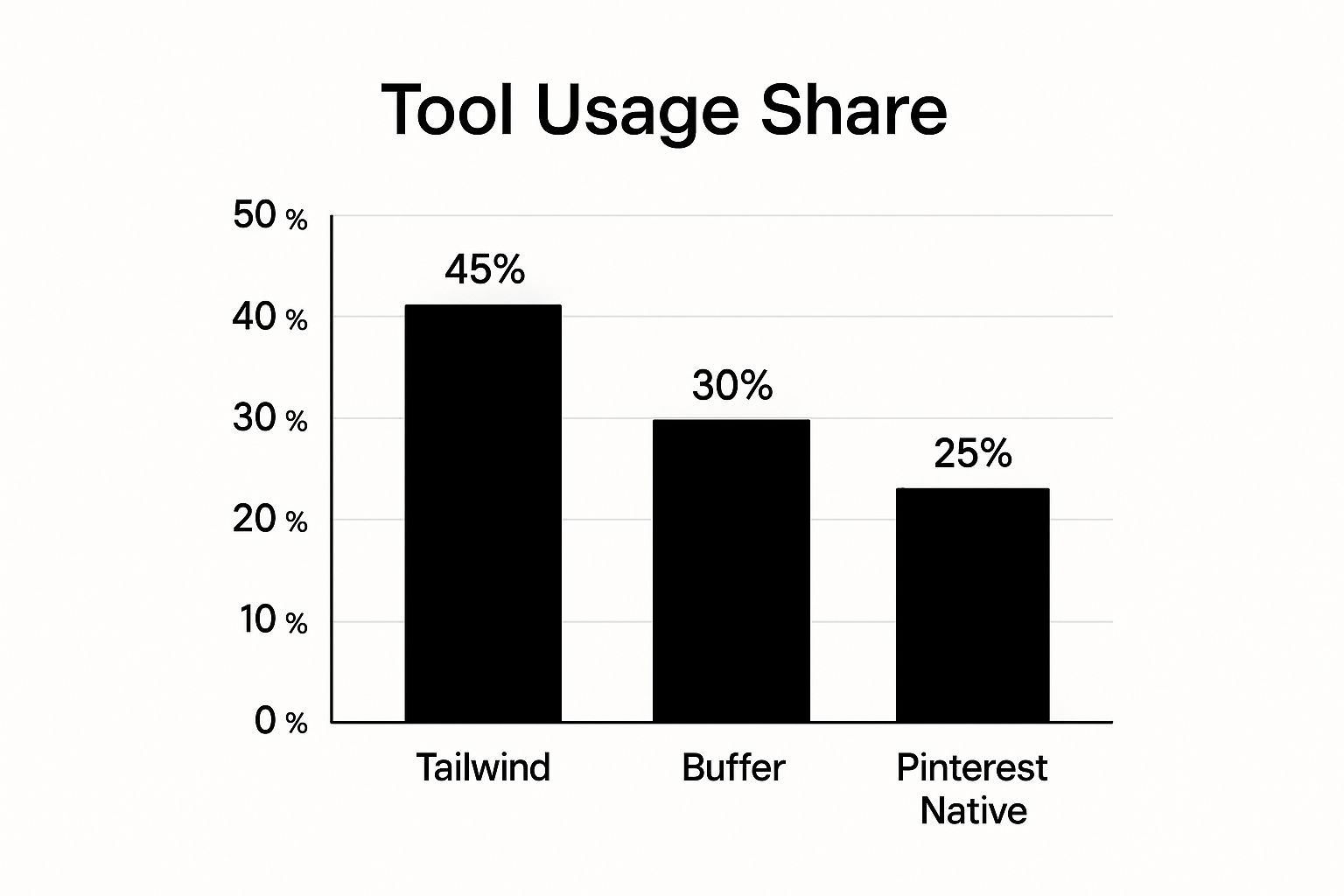How to Schedule Pinterest Posts: A Simple Guide
You can schedule Pinterest posts directly on the platform using Pinterest’s own tool, which is great for getting started. For more powerful features, though, a third-party app is the way to go. The basic process is simple: upload your Pin, craft a compelling description, and then pick the exact date and time you want it to publish.
Why Smart Scheduling Is Your Secret Weapon for Pinterest Growth

Let's be real—learning how to schedule Pinterest posts isn't just about clawing back a few minutes in your day. It’s about getting the Pinterest algorithm to work for you. When you ditch the random, whenever-I-have-time pinning for a deliberate, scheduled strategy, you’re basically telling the platform you mean business.
This consistency signals that you're a dependable source of fresh, quality content. Pinterest’s algorithm is built to reward active and predictable creators. A steady flow of new Pins is one of the strongest signals you can send that your account is worth showing to more people.
Building Trust with the Algorithm
Imagine the Pinterest algorithm as a meticulous editor for a high-end magazine. It’s constantly searching for the best, most relevant content to feature. An account that's all over the place—dumping 20 Pins in one day and then going radio silent for a week—is just unpredictable and messy.
On the other hand, an account that consistently shares a few well-crafted Pins every single day establishes a pattern of reliability. Over time, this methodical approach is what earns you better distribution and more eyes on your content.
Beyond Convenience: The Strategic Advantages
Switching to a scheduled workflow gives you a strategic edge that's nearly impossible to get when you're just live pinning. It's the difference between simply using Pinterest and building a powerful content engine for your brand.
Here’s where you really see the benefits:
Choosing Your Ideal Pinterest Scheduling Tool
Feeling a bit overwhelmed by all the Pinterest scheduling tools out there? It’s a common feeling. Picking the right platform really boils down to your specific situation—are you a solo blogger, a small e-commerce shop, or a marketing agency managing a dozen accounts?
Your first big decision is whether to stick with Pinterest’s own scheduler or go for a more robust, third-party tool. While Pinterest's built-in option is a fine place to start, it just doesn't have the horsepower you need for a serious growth strategy.
Native Scheduler vs. Third-Party Powerhouses
Pinterest's own scheduling feature is free and gets the basic job done. You can schedule a single Pin up to two weeks in advance on your computer or 30 days on your phone. The catch? You can only schedule one Pin at a time. Even worse, if you spot a typo after you’ve scheduled it, you have to delete the whole thing and start from scratch. It gets old, fast.
This is where third-party schedulers come in. For anyone serious about using Pinterest to drive real traffic and sales, tools like Tailwind, Buffer, and Later are the real deal. They’re built from the ground up with features designed for efficiency and performance—things you simply won’t find in the native tool.
Features That Actually Matter
When you start comparing tools, it's easy to get lost in a long list of shiny features. My advice? Focus on the ones that will genuinely save you time and deliver measurable results.
Here are the non-negotiables I always look for:
To give you an idea of what serious marketers are using, take a look at this breakdown.

The data speaks for itself. Specialized tools like Tailwind dominate the market because pros understand the value of advanced features that go way beyond basic scheduling. If you want to learn more about the different methods, we have a complete guide that shows you how to schedule Pins on Pinterest step-by-step.
Making the Right Choice for You
So, how do you decide which tool is the one? To make it easier, here’s a quick comparison to help you match a platform to your specific goals and budget.
Pinterest Scheduling Tool Feature Comparison
Choosing the best Pinterest scheduling tool can feel daunting, but this table breaks down the most popular options to help you find the perfect fit for your strategy and budget.
At the end of the day, the right tool should fit seamlessly into your workflow and help you reach your goals. While the native scheduler is a decent starting point, investing in a dedicated platform is a strategic move that pays for itself many times over in traffic, engagement, and—most importantly—your time.
Building a Posting Schedule That Actually Works

Let’s be honest: generic advice on when to post is everywhere, but a Pinterest schedule that actually moves the needle isn't one-size-fits-all. It’s a personalized rhythm built around your specific audience and content. The real goal here is to stop guessing and start building a data-driven strategy that delivers real, consistent results.
The key to it all is consistency. Pinterest's algorithm absolutely loves a steady, predictable flow of Pins. Chaotic bursts of activity followed by radio silence just won't cut it. A consistent schedule signals that you're a reliable source of great content, which can do wonders for your visibility.
Uncovering Your Audience's Peak Hours
You can safely ignore all those "best times to post" articles. Seriously. The most valuable data you can get is hiding in plain sight, right inside your own Pinterest Analytics. This is where you'll find the exact days and hours your followers are most active and ready to engage.
To find this goldmine of information, head over to your Pinterest business account and navigate to Analytics > Audience Insights. You'll see "Total audience" and "Engaged audience" tabs. Zero in on the demographic data, which clearly shows you the days and times your audience is most likely to be scrolling. This is your new source of truth.
This data lets you build a schedule that aligns perfectly with your audience’s actual behavior, not some vague industry average.
Getting the Right Mix of Content Frequency and Pin Variety
Once you know when to post, the next piece of the puzzle is figuring out what and how often. I’ve seen so many accounts fall into the trap of scheduling the same type of Pin over and over. A truly effective strategy needs a balanced mix of different Pin formats to capture the full potential of the platform.
A healthy weekly schedule should include a variety of these:
To make sure your Pinterest activity is actually helping your business grow, it’s a smart move to start with a winning content marketing plan template. This will help you align your Pins with your bigger business goals from the get-go.
Sample Weekly Scheduling Templates
Putting this all together can feel overwhelming, so here are a couple of real-world examples to get you started. Just remember to tweak these based on what your own analytics are telling you.
For an E-commerce Brand:
For a Food Blogger:
Pinterest really favors this kind of structured, thoughtful approach. We've seen that a consistent posting rhythm is crucial, and different days and times call for different types of content. For example, scheduling a few educational Pins on a Monday evening while saving your fun, lifestyle content for a Saturday morning helps you tap into different user mindsets throughout the week.
Mastering Pin Optimization and Bulk Scheduling

Alright, you've got your schedule figured out. Now for the real work: getting your Pins prepped and ready for prime time. This is where we shift from when to post to how to post efficiently. It all comes down to two things that will completely change your workflow: Pin optimization and bulk scheduling.
I can't stress this enough: every single Pin you create is a tiny, searchable asset. It needs the right keywords and a killer design to actually get seen and clicked. Rushing this part is a huge mistake. This is your moment to make sure your content doesn't just get posted but actually performs.
What Every High-Performing Pin Needs
Before a Pin ever makes it into your scheduler, it needs to be built for success. Think of your scheduling tool as the delivery truck. The truck can be fast and reliable, but if the package it's delivering is unappealing, no one's going to open it.
So, what goes into a great Pin? Make sure these three elements are part of your creation process every single time.
While a great Pin is key, don't forget where that Pin leads. Optimizing your landing page or link-in-bio is just as crucial for turning that traffic into results. If you're looking for inspiration, checking out the best link in bio examples for social media success can really spark some ideas for creating a better user experience.
The Magic of Bulk Scheduling Your Pins
This is the secret that separates the pros from the hobbyists. Bulk scheduling is exactly what it sounds like: uploading and scheduling a massive batch of Pins all at once. Instead of the daily chore of logging in, you can set up an entire week or even a month of content in a single afternoon.
Most serious scheduling tools have a bulk uploader. Typically, you can just fill out a simple CSV file with your Pin titles, descriptions, destination URLs, and image file names. Upload it, and the tool populates your entire queue. A quick review, and you're done.
This is how you maintain a powerful, active presence across multiple boards without the daily grind. It frees you up to focus on the things that actually grow your business. If you're ready to make this happen, our guide on finding the right Pinterest scheduler will help you pick a tool with the powerful bulk features you'll need.
How to Analyze and Refine Your Schedule Over Time
https://www.youtube.com/embed/mvCRaor32TY
Alright, you’ve got your initial schedule set up. That’s a huge first step, but the real work—and the real results—begin now. The biggest mistake I see people make is treating their Pinterest schedule as a "set it and forget it" task. To really get ahead, you have to think of it as a living, breathing part of your strategy.
The magic happens when you stop guessing and start letting data guide your decisions. This means regularly diving into your analytics, both inside your scheduling tool and on Pinterest itself, to see what’s actually working. Your mission is to find the patterns. Are certain Pins driving all your traffic? Are specific time slots consistently blowing others out of the water? The answers are right there in your metrics.
Key Metrics to Track for Schedule Optimization
To sharpen your schedule, you need to look past vanity metrics. Impressions are nice, but they don't pay the bills. They tell you how many people saw your Pin, but engagement metrics tell you if they actually cared enough to do something about it.
Get in the habit of tracking these core performance indicators every month:
Conducting Your Monthly Performance Review
Block out an hour on your calendar each month for a quick performance audit. I like to open my Pinterest Analytics and my scheduler’s dashboard side-by-side to get the full picture. Filter for your top-performing Pins from the last 30 days.
Then, start asking the important questions:
This constant process of tweaking and refining is what turns scheduling from a simple chore into a powerful growth engine. If you really want to get granular with your timing strategy, take a look at our guide on the best time to pin on Pinterest for more data-backed tips. By iterating based on what you learn, you’ll see your results get better and better over time.
As you start scheduling Pins, a few questions inevitably pop up. Don't worry, that's completely normal. Everyone wonders about the "right" number of Pins, the best way to repin content, and whether using a scheduling tool will get them in trouble. Let's tackle these common uncertainties so you can build your Pinterest schedule with confidence.
How Many Pins Should I Schedule a Day?
This is easily the most common question I hear. While everyone wants a magic number, the truth is, quality always trumps quantity on Pinterest.
A great starting point for most accounts is scheduling anywhere from 3 to 10 unique Pins per day. Consistency is what really moves the needle, not just flooding your followers' feeds. By spreading these Pins out, you also get a better shot at reaching people who are online at different times.
If you have a brand-new account, you might stick closer to the lower end of that range. For a more seasoned account with a lot of content to pull from, pushing toward the higher end makes sense. The real key is to keep an eye on your analytics and see what's actually working for your audience.